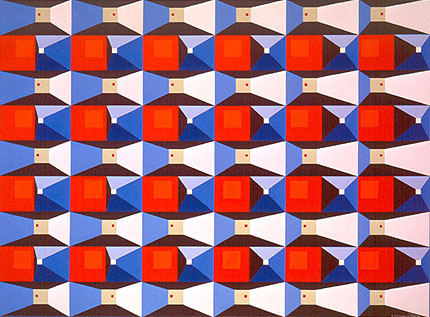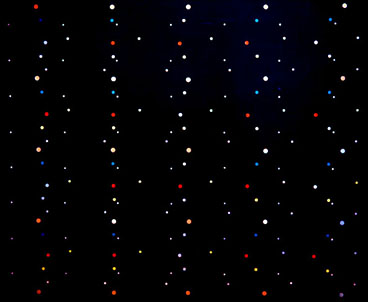
(Photo: Robert Cameron)
I’ve singled out Transpositions because it exemplified what I termed in my manifesto in 1972, new directions for a free-vision cross-stereo application of the “cyclopean field” or to what some refer to as stereo-paired ‘repetition’ or ‘wall-eyed’ stereopsis. My vision was to project this visual phenomenon into a new stereo-spatial aesthetic of scale in both the fine and applied arts during the early 70’s.Predating Transpositions I returned in 1966-70 to an older interest in creating stereoscopic single pair free-vision (cross-sight) drawings. Through these new experiments, I re-discovered (Brewster, 1856) the phenomena of stereo-paired repeated pattern arrays that could remarkably be viewed by both parallel and cross-stereo free vision. As a result of this Transpositions was painted in March 1972, strongly influenced by my Sabbatical year travel to Iran in 1970 where I discovered the stunning repeated tile expanses in Mosques at Isfahan and Shiraz. I returned in 1971 determined to create large scale, convex/concave cross-stereo free vision stereo canvases and murals that would explore a new spatial aesthetic both in the fine and applied arts.
Independent of my stereo work in the late 60’s on the West Coast, other’s during this period were beginning to experiment with repeated (wall-eyed) stereo-pair arrays. One such painter in New York, Alphons Schilling, was exhibiting large stereo paintings of repeated dot patterns (Scattered and inclined, 1973); Stephen Best, in 1967 (Stereo Light Array) reportedly painted a stereo dot pattern in a light-box. Leading up to this, a few painters were exploring painting ‘single’ cross-stereo free vision stereo pairs, most notably, Marcel Duchamp and later, Oskar Fishinger in the late 40’s, Salvador Dali in the early 70’s with a handful of others following.
Transpositions was unique because it broke new ground and was an early example of an acrylic painting on canvas of a complex repeated stereo pair array exploring a stereo-spatial concave-convex space aesthetics in a rich multi-colored stereo field. This painting anticipated the work of Schilling, the computer autostereogram (C.W.Tyler, 1979), Wallpaper (wall-eyed), RDS and Color field stereogram.
To put this in a sobering historical sequence, Sir David Brewster (On The Stereoscope, 1856) discovered the effect of repeated stereo pairs writing about this in a chapter entitled: ‘On the Union of Similar Pictures in Binocular Vision’ and it is worth reading.If we, therefore, look at a papered wall, at the distance of three feet and unite (cross-sight free vision) two of the figures (two flowers united at the point of convergence of the optic nerve)…the whole wall or visible portion of it will appear covered with flowers…the whole papered wall with all its flowers will be seen suspended in the air at the distance of six inches from the observer! At first the observer does not decide upon the distance of the suspended wall from himself. It generally advances slowly to its new position, and when it has taken its place, it has a very singular character. The surface of it seems slightly curved. It has a silvery transparent aspect. It is more beautiful than the real paper, which is no longer seen, and it moves with the slightest motion of the head. If the observer, who is now three feet from the wall, retires from it, the suspended wall of flowers will follow him, moving farther and farther from the real wall, and also, but very slightly farther and farther from the observer. When he stands still, he may stretch out his hand and place it on the other side of the suspended wall, and even hold a candle on the other side of it to satisfy himself that the ghost of the wall stands between the candle and himself.
STELLATIONS I, stereo painting, acrylic, 72 x 84 in., 1972

(photo: Robert Cameron)
Transpositions was quickly followed by several other paintings in this genre: Stellations 1 was also unique in that it was painted for special reason with both reflective and phosphorescent paint on canvas. I wrote about this in 1972-4:“In another painting, Stellations No. 1 (Fig. 11), I have attempted to explore that quality of space evident in night city-scapes on starry nights, where points of light of varying degrees of luminosity, color and size appear to scintillate within a deep binocular field. This painting is made up of repeated stereoscopic pairs, as in Transpositions (Fig.9). The difference here, however, is that one views mostly empty space. I employed the optical mixture of colored dots by treating the left or right image of a dot pair with a different hue, value or chroma. Some of the dot pairs were painted exactly the same; some were painted using phosphorescent powders suspended in an acrylic medium. The combined effect of pairs that are optically mixed and those that are not gives the striking impression that the points are (atmospherically) giving off both direct and reflected light.”
(‘On Stereoscopic Painting’, Leonardo, Vol. 7, No. 2, pp. 97-104, Spring 1974); Manifesto, 1972. (Ferragallo)